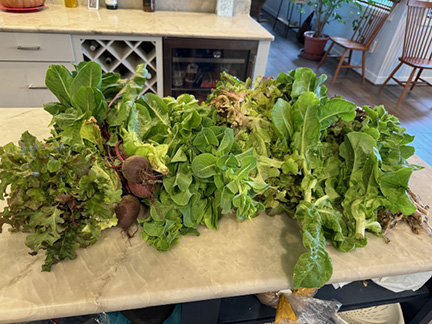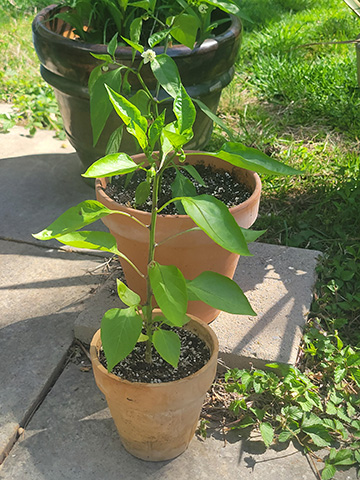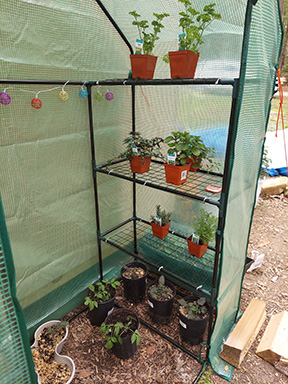So, you want to start a victory garden. Or your version of it. What next?
“You just put a trowel in the ground,” says Master Gardener Eileen Clements. “There’s almost no wrong away to begin.”
Other Master Gardeners agree. Sara Bedwell is growing in buckets drilled with drainage holes. Deb Silberg starts seeds in reused plastic pots, and plants out her seedlings into raised beds. Others add a few veg plants in a sunny perennial border. Barbara Flook seeds greens directly into raised beds and harvests salads all spring, fall, and often throughout winter. (The Kent County Master Gardeners have directions to make salad boxes, which they offer free). You can stuff a tomato or pepper plant or push a few bean seeds into a tub beside the kitchen door. There are probably as many ways to do this as there are people who want to experience the pleasure and satisfaction of producing food.
Deb Silberg began to grow some of her own fresh vegetables when she moved to Kent County.
“I was inspired by living in a community where people were interested in farming,” she says. “And I got inspired to try.”
Sara Bedwell grows tomatoes partly because hers taste so much better than the store-bought kind, which are often bred for transport rather than flavor. Flook wanted a broader selection of Asian greens than she found in the produce aisle.
Plus, growing your own is economical. For example, a $5 packet of Sungold tomato seeds produces enough plants to share some with the entire neighborhood. And each plant can provide about 40 quarts of cherry tomatoes, a huge savings. (Plus, you know, flavor).
Will your victory garden be perfect? Probably not. But it doesn’t have to be perfect to be satisfying. In any new enterprise, there is always a learning curve, but we have no shortage of people here who offer gardening advice. Not always useful,
but always well meant.
“It’s trial and error,” says Bedwell, who has been the recipient of some of that advice. “What works for one doesn’t necessarily work for everyone, so you learn what works best for you.”
Silberg agrees.
“I failed a few times,” she says. “I talked with a few people at The Mill, who were so helpful. And I pestered the Master Gardeners at the booth so often that they suggested I take the course!” (Which she did).
“Learning by failure is the only way to do it,” agrees Flook. (The old adage is: ‘You’re not really a gardener until you’ve killed at least 100 plants). Flook’s gardens have morphed considerably over the years. “When I began, I double-dug my garden,” she says. (Double digging was then in vogue along with French intensive gardening, both of which are just as exhausting as they sound). “If I had it to do over, I’d just have thrown a carboard flat on the ground to kill everything underneath it and then be ready to start in the spring” she says now.
Regardless of how you approach it, start small. It’s better to have less space than you think you want and expand as you gain knowledge and experience rather than to get overambitious, overwhelmed, and discouraged.
“Not having too much space to deal with was kinda my goal,” says Bedwell, who works two jobs and is in the process of clearing a piece of ground for a bigger gardening project. Containers limit the work since they are a snap to weed and water. They also offer an easy way to experiment with positioning. “We’ve started with buckets because pots and buckets can be moved.”
If you’re starting in-ground, south-facing is best – vegetables and fruits need a minimum of six-eight hours of direct sunlight daily.
“Choose carefully where you’re gonna put that garden because you need to have sun and access to water,” Flook advises.
Once that choice has been made, Flook urges gardeners to: “Plant what you like to eat. Lettuce and greens, which are easy to grow, work well in containers and raised beds, and are so good for you,” she says. “They also tend to be ready to eat within about six-seven weeks from seed.”
This is especially good for young gardeners. It’s not instant gratification, but it’s swift enough to be both encouraging and educational. Peas, beans, herbs, (which are often quite expensive), and greens, all of which usually germinate in about 5-8 days, and grow fairly quickly, are great for youngsters to start with. And, if you let the seeds of pole beans dry on the vine then store them in an air-tight container in a cool place, you can plant them next year, another savings.
“I started with a lot of tomatoes and peppers and things that were easier to grow,” says Silberg. “And I kind of expanded because I’m feeling more confident now.”
Determinate tomatoes (often hybrids), which grow to a genetically predetermined size and production, are usually better for pots but will also do well in the ground. Indeterminate tomato varieties (often heirloom) continue growing and producing until frost gets them, but are usually too rangy for pots, though doable if you set up a sturdy support to attach them to and secure it so the pot doesn’t fall over in a wind.
Whatever way you decide to start, know that you’re in good company and have plenty of local encouragement.
“The sense of producing something that you can eat and share was really compelling to me,” says Silberg. “I grow flowers, but I share a lot more of the things I grow to eat, and I have seedlings that I can give away and they can grow it, and that makes me happy, too!”
https://extension.umd.edu/programs/environment-natural-resources/program-areas/home-and-garden-information-center/master-gardener-program/about-program/grow-it-eat-it/





Write a Letter to the Editor on this Article
We encourage readers to offer their point of view on this article by submitting the following form. Editing is sometimes necessary and is done at the discretion of the editorial staff.